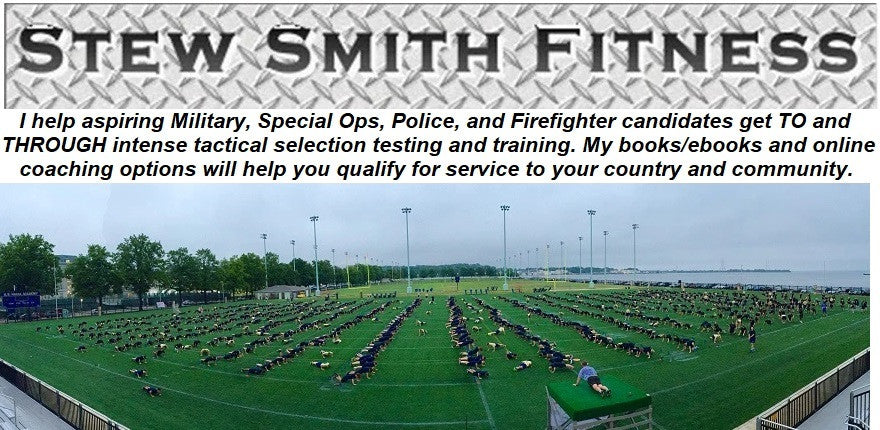Typical Errors and Corrections with the Combat Swimmer Stroke
1 – Kick off the wall – Kick off hard like you are trying to jump and grab the rim of a basketball hoop – just horizontally in this case. Stay streamlined with hands interlocked and biceps on your ears. Hold the glide off the wall for about 4-5 seconds, add in a double arm pull, kick and recover your arms over the head – hold that glide for a few seconds. THEN start your stroke (top arm pull…See #8 for full sequence)
~ search “breast stroke pullout” for the way to do the double arm pull off the wall.
2 -Waste of Energy - WAY too many kicks. The flutterkicks will add up to likely about 500 flutterkicks by the time you finish 500yds if you are constantly kicking during your glide position. This will seriously affect your other PST scores (run, situps, overall energy remaining)
3 - Your top arm / breathing cycle is off: You need to turn your head to breath as your top arm passes your torso
~ also search "freestyle catch" for the top arm pull method that will help you.
4 - You inhale with the bottom arm pull. DO NOT turn and breathe during the bottom arm pull.
~ also search "breaststroke scull" for the bottom arm pull method that you need.
5 – Pop Head up to breathe – Instead of popping the head up to breathe like you were doing the breast stroke, turn your head like you are doing freestyle.
6 - Your kick - needs to be a scissor kick or breast stroke kick - then keep your feet together and glide - no need to 100s of flutterkicks. An additional dolphin kick during the glide is acceptable.
7 - Your glide - should be held for 2-3 seconds. (1 Mississippi, 2 Mississippi, Pull on THREE)
~ stay streamlined like a torpedo. You need to glide with arms overhead / biceps on your ears, hands locked one on top of the other.
8 – Side or Stomach Roll – It is up to you if you want to roll on your stomach after the kick / during the glide. Some like to stay on their side / some roll over. IF you have your shoulder breaking the surface during the glide, you need to roll over to avoid the extra drag and surface tension.
9 - Overall sequence: Top arm pull, turn to breathe, bottom arm pull - inhale, kick and recovery arms overhead (streamlined), glide / exhale. REPEAT.
Reference Videos
See Three Part Breakdown of the CSS
More Programming Assistance:






It depends: The Complete Guide to Navy SEAL Fitness is a classic and focuses on high rep calisthenics and running and swimming base. You will build up your running over 12-18 weeks to 20 miles but very fast paced focus on both the 1.5 mile run for the PST and the 4 mile timed run for weekly run test at BUDS. If you are an athlete with a strong power / strength background in lifting and not running or swimming, Navy SEAL Fitness is ideal for you. IF you need some place to start Navy SEAL Fitness is ideal for you as well because a calisthenics base / running / swimming progression is a good place to build a foundation. Though you will likely need to spend some time in the Navy SEAL Weight Training Book OR if Navy SEAL FItness is too challenging, go with Navy SEAL SWCC, EOD, Diver, PST Phase 1 Workout. Phase 1 is a good starting point if Navy SEAL Fitness program is too tough.
Navy SEAL Weight Training - This is part two (winter lifting phase) of my SEAL Prep program. If you have done the Navy SEAL Fitness (12 weeks to BUDS) program a few times and need a break, this is the next program that integrates lifting with the Navy SEAL Prep training. This is ideal for people who have come from an endurance athlete background. Athletes like swimmers and runners will also require some strength training as you will be exposed to challenges under logs and boats during the first phase and many miles of rucking 50+ lbs of backpacks and gear in 2nd and 3rd phases of BUDS. Do not skip lifting in your year of training prep. However, if you are coming from a powerlifting / football background, supplementing a few lifts into your endurance / muscle stamina focus plan is something you may enjoy especially if training for a year or more during your prep phase.
Navy SEAL / SWCC, EOD, Diver Program Series - Phase 1 is what I call a beginner guide, but it is still challenging. It is geared toward those who are scoring minimally or failing their Navy PST test - 500yd swim, pushups, situps, pullups, 1.5 mile run. It is easier than The Complete Guide to Navy SEAL Fitness and a good prep course before attempting it.
Phase 2 and 3 of the Navy SEAL / SWCC, EOD, Diver program is about the same level of intensity as Navy SEAL Fitness and is also a good follow-up plan after Phase 1.
Phase 4 ot the Navy SEAL Key to Mental Toughness is by far my toughest workout ever created. It resembles a day of BUDS, complete with "wet and sandy", runs after eating, high rep punishment push-ups, 4 mile timed runs, 2 mile swims with fins, log PT simulation, and even a HellWeek Simulator with 3 workouts a day.

